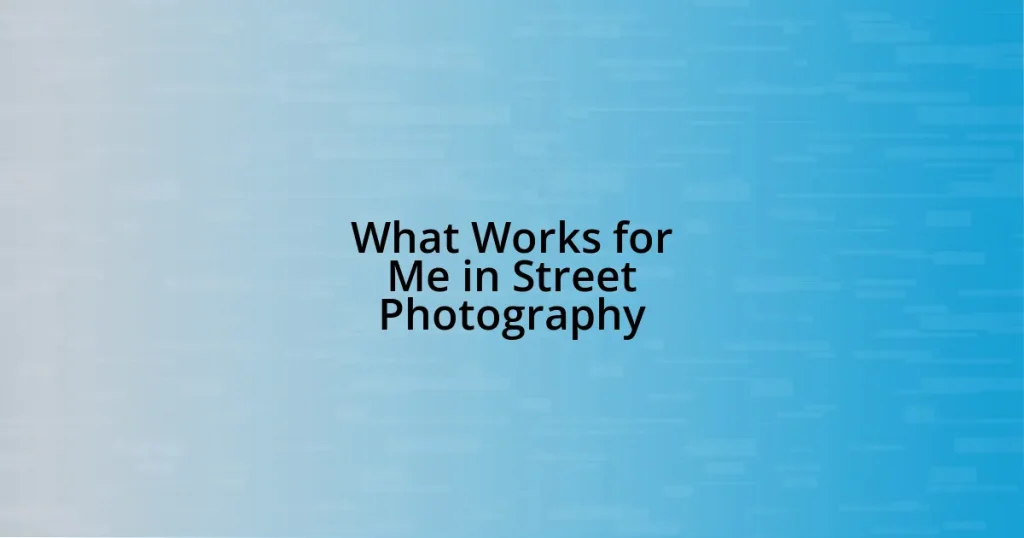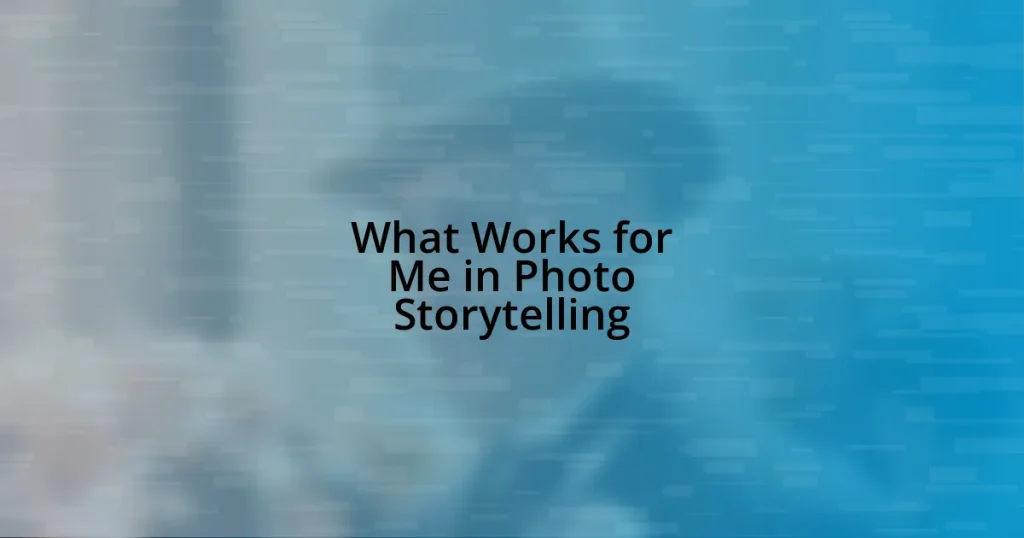Key takeaways:
- A photo essay is about storytelling, where each image contributes to a larger narrative.
- Choosing a meaningful and specific theme enhances the emotional connection and coherence of the essay.
- Organizing photographs based on emotions and themes aids in creating a rhythmic flow and emotional progression in the narrative.
- Self-publishing offers creative control, while traditional publishing provides broader distribution and marketing support; both have their unique advantages.

Understanding photo essay fundamentals
Understanding the fundamentals of a photo essay starts with recognizing that it’s not just about beautiful images; it’s about storytelling. Reflecting on my own experience, I realized that each photograph ought to contribute to a larger narrative. What message do I want to convey? This question guided my selection process and helped me focus my vision.
Another essential element is the flow of the visual narrative. When I started curating my photo essay, I often felt overwhelmed by the sheer number of images I loved. I asked myself, “How do I connect these moments?” By creating a chronological or thematic sequence, I found a rhythm that resonated, allowing viewers to feel the emotional journey I intended to share.
Lastly, the impact of captions cannot be underestimated. Early on, I underestimated their importance. However, I quickly learned that a few thoughtfully crafted words can enhance understanding and evoke deeper emotions. It’s fascinating how a simple line can transform a visual experience, inviting viewers to pause and reflect.

Choosing a meaningful theme
Choosing a meaningful theme is crucial to creating a cohesive photo essay. In my experience, diving deep into what resonates with me has always led to the most impactful themes. For instance, when I centered my essay around the concept of “Resilience,” each photo began to take on a life of its own, weaving together a story of challenges and triumphs. This made my selection process much more straightforward, almost like following a guiding light through a dense forest.
As I navigated various themes, I discovered that some felt too broad, making it challenging to capture a specific essence. I remember contemplating themes like “Nature” or “Urban Life,” but they felt expansive and unfocused. By focusing on “Urban Resilience,” I honed in on stories of individuals overcoming hardships in city environments. This specificity not only enhanced the visual narrative but also made it easier for viewers to connect with the emotions I aimed to convey.
Ultimately, the theme you choose should resonate with your personal experiences and aspirations. I’ve always found that when I select a theme that aligns with my passions, the entire curation process flows more effortlessly. It’s almost as if the images choose themselves, beckoning me to tell their stories. This connection makes the project deeply fulfilling, turning what could be a simple collection of photos into a powerful visual narrative.
| Broad Themes | Meaningful Themes |
|---|---|
| Nature | Urban Resilience |
| General Life | Struggles of Immigrants |
| Travel | Journeys of Healing |

Selecting and organizing photographs
Selecting and organizing photographs for my photo essay was an enlightening journey. I recall sifting through hundreds of images, feeling a mix of excitement and anxiety. To streamline this process, I began by creating distinct categories based on emotions and themes. This helped me envision how each photo could interact with the others.
Here’s how I approached the selection and organization:
- Identify Key Moments: I honed in on images that encapsulated significant emotions or events.
- Create Visual Groups: I clustered photos that had a natural connection, like colors, subjects, or locations.
- Establish A Timeline: Arranging photos chronologically gave my narrative a sense of progression and flow.
- Seek Feedback: I shared my selections with trusted friends, gaining fresh perspectives that helped refine my choices.
I found that stepping back and viewing the curated collection as a whole was incredibly beneficial. It allowed me to see if the arrangement conveyed the intended emotional arc. By adjusting the order, I could amplify or diminish certain feelings, shaping how viewers would connect to the story I wanted to tell. There’s something truly satisfying in finding that perfect placement that clicks into place like the last piece of a jigsaw puzzle.

Crafting a compelling narrative
Crafting a compelling narrative requires a delicate blend of intention and intuition. I often find myself asking, “What story do I want to tell?” When I embarked on my photo essay journey, I discovered that each image could potentially lead to a variety of narratives, depending on how I chose to frame them. For instance, one photograph I shot of an elderly woman sitting on a bustling city bench could evoke feelings of solitude or community, depending on the surrounding images and the narrative I aimed to construct. This realization illuminated the importance of coherence in not just individual photos but in the story they tell together.
Another poignant lesson I learned is the power of emotion in storytelling. I vividly remember including a photo of a young child laughing amidst a chaotic street protest. Initially, I was unsure if it belonged. However, I noticed how this moment of joy amidst turmoil created a striking contrast that enhanced my narrative on urban resilience. It wasn’t about merely documenting events; instead, it was about how those moments shared a deeper emotional truth. Isn’t that what we all seek to connect with—a glimpse of humanity that strikes a chord within us?
As I pieced together my narrative, I also embraced the art of tension and release. Each section of the photo essay served a purpose, shifting from moments of struggle to scenes of hope. It’s almost like composing music where each photo acts as a note, building to an emotional crescendo. I learned that engaging with the audience means instilling curiosity and emotion. The challenge was not only to document a theme but to guide viewers through a journey they could feel, relate to, and perhaps even see themselves in. That’s what makes a narrative not just compelling but unforgettable.

Designing the book layout
When it came to designing the book layout, I found it essential to strike a balance between visual appeal and narrative coherence. Initially, I sketched a rough draft layout on paper, playing around with different arrangements to see what felt visually engaging. I remember the moment I realized that the white space around the images wasn’t just a filler; it allowed the photos to breathe and speak on their own. How often do we overlook the power of negative space in design? For me, it shifted the focus back to the emotional impact of each photograph.
As I began to place photos onto pages, I found that consistency mattered. I chose a particular font and size for the captions that complemented my style—an elegant serif that added a touch of warmth. Seeing the text and images work together was incredibly fulfilling. I wondered how much our choice of typography could influence a viewer’s initial reaction. The right font can evoke a sense of nostalgia or modernity, and I wanted my audience to feel as though they were stepping into a world reflective of the emotions behind the photographs.
Finally, when laying out the sequence, I paid attention to transitions between images. I often think about how surprising it can be to witness the juxtaposition of emotions in a series. One page depicting serene landscapes seamlessly led to a bustling city scene, creating a visual conversation that flowed effortlessly. It’s like storytelling through visual rhythms—each page turned should feel like a heartbeat, gently guiding the viewer deeper into the essay. Designing my book wasn’t simply an exercise in layout; it felt like orchestrating a journey, where every choice was a note in a larger symphony of visual storytelling.

Publishing options for photo essays
Choosing the right publishing option for a photo essay can feel overwhelming. I remember wrestling with this decision while working on my first book. Should I go for traditional publishing or self-publishing? After much contemplation and research, I leaned toward self-publishing because it allowed me to maintain creative control. The freedom to curate my project without needing to conform to someone else’s vision was essential to me.
While exploring self-publishing, I discovered a variety of platforms like Blurb and Lulu, which are relatively easy to use for beginners. They handle printing, distribution, and even offer design templates that can help streamline the process. It’s almost like having a creative partner at your side—one that supports your vision without imposing constraints. Wouldn’t it be empowering to see your unique interpretation of the world come to life exactly as you imagined it?
However, traditional publishing still has its perks, particularly in terms of broader distribution and marketing support. I once attended a seminar where an experienced photographer shared how entering competitions for traditional publishing opportunities led to unexpected connections and professional growth. I thought how exciting it must be to have industry experts promote your work. But for me, I valued the personal touch of self-publishing, often equating the process to self-discovery rather than just a means to an end. Each option comes with its own set of advantages and challenges, and I found it uplifting to know that my choice was a reflection of my artistic journey.

Promoting your photo essay book
Promoting your photo essay book is much like curating the collection itself; it requires a thoughtful approach. When I first set out to promote my own book, I realized that leveraging social media was crucial. I started by sharing snippets of the book on platforms like Instagram, where I could showcase not just the final images but also behind-the-scenes moments, such as my creative process. I vividly recall the day I posted a video of flipping through the pages; it felt like inviting my audience into my living room to share my story intimately.
Another impactful strategy was hosting a launch event. I remember feeling a mix of excitement and nerves as I prepared my speech, wanting to connect with the attendees on a personal level. Sharing anecdotes about each phase of my creative journey fostered a deeper connection with my audience. It was rewarding to see them engage with the book not just as a product, but as a culmination of emotions, insights, and shared experiences. Have you ever felt that electrifying connection with someone over a shared passion? That’s exactly what I aimed to recreate during my event.
Email newsletters formed another vital part of my promotional strategy. I found that directly communicating with my audience created a sense of community. I used the platform to share not only updates about my book but also reflections on topics related to photography and art. I often would ask open-ended questions to encourage dialogue, like, “What emotions do you feel when capturing a moment?” This approach reinforced the bond I sought with my readers, portraying the book not just as an object for sale but as a shared journey in art and storytelling.
















